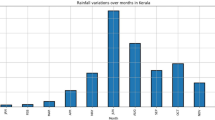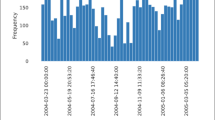Abstract
In recent years, shifts in weather patterns have become increasingly apparent, leading to a rise in the frequency and severity of severe weather-related disruptive events across the globe. These events, which can include floods, storms, heavy rain, high winds, winter storms, heavy snow, and blizzards, pose a significant threat to public health and safety, as well as having negative economic impacts on key sectors such as agriculture, critical infrastructure, and emergency management. To address this challenge, our paper proposes a multi-modal learning approach for predicting and estimating risk for disruptions, by integrating weather- related data from multiple sources, including text and sensor recordings. Through experimental evaluation on a dataset of hourly weather data from three different climates - Alaska, Nevada, and Pennsylvania - we demonstrate that our approach outperforms alternatives that rely solely on weather recordings.
Access this chapter
Tax calculation will be finalised at checkout
Purchases are for personal use only
Similar content being viewed by others
References
Chanda, A.K.: Efficacy of BERT embeddings on predicting disaster from Twitter data. arXiv preprint arXiv:2108.10698 (2021)
Dai, A., Karl, T.R., Sun, B., Trenberth, K.E.: Recent trends in cloudiness over the United States: a tale of monitoring inadequacies. Bull. Am. Meteorol. Soc. 87(5), 597–606 (2006)
Frame, J.M., Kratzert, F., Klotz, D., Gauch, M., Shalev, G., Gilon, O., Qualls, L.M., Gupta, H.V., Nearing, G.S.: Deep learning rainfall-runoff predictions of extreme events. Hydrol. Earth Syst. Sci. 26(13), 3377–3392 (2022)
Free, M., Sun, B.: Time-varying biases in us total cloud cover data. J. Atmos. Oceanic Technol. 30(12), 2838–2849 (2013)
Frew, E.W., Elston, J., Argrow, B., Houston, A., Rasmussen, E.: Sampling severe local storms and related phenomena: using unmanned aircraft systems. IEEE Robot. Autom. Mag. 19(1), 85–95 (2012)
Gowda, T., You, W., Lignos, C., May, J.: Macro-average: rare types are important too. arXiv preprint arXiv:2104.05700 (2021)
Gultepe, I., et al.: A review of high impact weather for aviation meteorology. Pure Appl. Geophys. 176, 1869–1921 (2019)
Hasan, N., Uddin, M.T., Chowdhury, N.K.: Automated weather event analysis with machine learning. In: 2016 International Conference on Innovations in Science, Engineering and Technology (ICISET), pp. 1–5. IEEE (2016)
de Lima, G.R.T., Stephany, S.: A new classification approach for detecting severe weather patterns. Comput. Geosci. 57, 158–165 (2013)
Matsueda, M., Nakazawa, T.: Early warning products for severe weather events derived from operational medium-range ensemble forecasts. Meteorol. Appl. 22(2), 213–222 (2015)
National Centers for Environmental Information: National centers for environmental information homepage (2024). https://www.ncei.noaa.gov. Accessed 21 Feb 2024
Nemoto, K., Hamaguchi, R., Imaizumi, T., Hikosaka, S.: Classification of rare building change using CNN with multi-class focal loss. In: IGARSS 2018-2018 IEEE International Geoscience and Remote Sensing Symposium, pp. 4663–4666. IEEE (2018)
Niu, Z., Yu, Z., Tang, W., Wu, Q., Reformat, M.: Wind power forecasting using attention-based gated recurrent unit network. Energy 196, 117081 (2020)
Olteanu, A., Castillo, C., Diaz, F., Kıcıman, E.: Social data: biases, methodological pitfalls, and ethical boundaries. Front. Big Data 2, 13 (2019)
Otudi, H., Gupta, S., Albarakati, N., Obradovic, Z.: Classifying severe weather events by utilizing social sensor data and social network analysis. In: Proceedings of the 2023 IEEE/ACM International Conference on Advances in Social Networks Analysis and Mining. Kusadasi, Turkey (November 2023, in press)
Powell, M.D.: Wind measurement and archival under the automated surface observing system (ASOS): user concerns and opportunity for improvement. Bull. Am. Meteorol. Soc. 74(4), 615–624 (1993)
Prasetya, D.A., Nguyen, P.T., Faizullin, R., Iswanto, I., Armay, E.F.: Resolving the shortest path problem using the haversine algorithm. J. Crit. Rev. 7(1), 62–64 (2020)
Schroeter, S., et al.: Forecasting the impacts of severe weather. Aust. J. Emerg. Manag. 36(1), 76–83 (2021)
de Souza, C.V.F., Barcellos, P.D.C.L., Crissaff, L., Cataldi, M., Miranda, F., Lage, M.: Visualizing simulation ensembles of extreme weather events. Comput. Graph. 104, 162–172 (2022)
Sparkman, R.M.: Regional geography, the overlooked sampling variable in advertising content analysis. J. Curr. Issues Res. Advert. 18, 53–57 (1996). https://api.semanticscholar.org/CorpusID:129491273
Styve, L., Navarra, C., Petersen, J.M., Neset, T.S., Vrotsou, K.: A visual analytics pipeline for the identification and exploration of extreme weather events from social media data. Climate 10(11), 174 (2022)
Sun, B.: Cloudiness over the contiguous united states: contemporary changes observed using ground-based and ISCCP D2 data. Geophys. Res. Lett. 30(2) (2003)
Wang, L., Tao, R., Hu, H., Zeng, Y.R.: Effective wind power prediction using novel deep learning network: stacked independently recurrent autoencoder. Renew. Energy 164, 642–655 (2021)
Yu, R., et al.: Scene learning: deep convolutional networks for wind power prediction by embedding turbines into grid space. Appl. Energy 238, 249–257 (2019)
Zhu, R., Liao, W., Wang, Y.: Short-term prediction for wind power based on temporal convolutional network. Energy Rep. 6, 424–429 (2020)
Acknowledgements
This research was sponsored by the U. S. Army Engineer Research and Development Center (ERDC) and was accomplished under Cooperative Agreement Number W9132V-23-2-0002. The views and conclusions contained in this document are those of the authors and should not be interpreted as representing the official policies, either expressed or implied, of the U.S. Army Research Engineer and Development Center (ERDC) or the U.S. Government. During this work, Mr. H. Otudi was funded by the College of Computer Science and Information Technology at Jazan University in Saudi Arabia.
Author information
Authors and Affiliations
Corresponding author
Editor information
Editors and Affiliations
Rights and permissions
Copyright information
© 2024 The Author(s), under exclusive license to Springer Nature Switzerland AG
About this paper
Cite this paper
Otudi, H., Gupta, S., Obradovic, Z. (2024). Leveraging Diverse Data Sources for Enhanced Prediction of Severe Weather-Related Disruptions Across Different Time Horizons. In: Iliadis, L., Maglogiannis, I., Papaleonidas, A., Pimenidis, E., Jayne, C. (eds) Engineering Applications of Neural Networks. EANN 2024. Communications in Computer and Information Science, vol 2141. Springer, Cham. https://doi.org/10.1007/978-3-031-62495-7_17
Download citation
DOI: https://doi.org/10.1007/978-3-031-62495-7_17
Published:
Publisher Name: Springer, Cham
Print ISBN: 978-3-031-62494-0
Online ISBN: 978-3-031-62495-7
eBook Packages: Computer ScienceComputer Science (R0)




